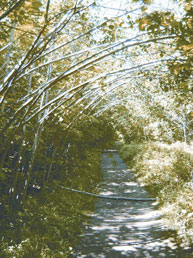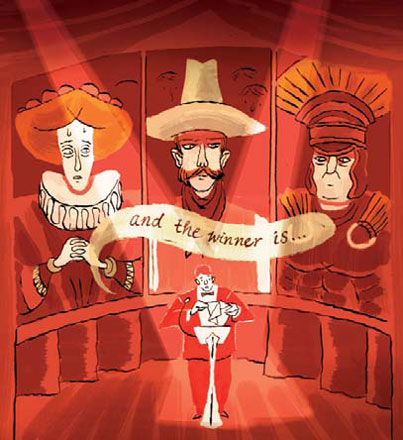Newsbites (Page 2)
Another Kind of History

A walking path on the Gault Nature Reserve
Michael Bourguignon
In 1958, Andrew Gault bequeathed his estate on Mont St-Hilaire to McGill, to preserve his "most treasured possession… for all time to come." But some had other ideas: turn the mountain into a ski hill or cut the forest for timber. Fortunately, a young botany professor named Paul Maycock argued that, with the only first-growth forest in the St. Lawrence Valley, the mountain was a priceless resource.
Time has proven him right. Now celebrating its 50th anniversary, the Gault Nature Reserve is "a vibrant living laboratory and museum," says biology professor Martin Lechowicz, the director of the reserve.
It might also be one of McGill's best-kept secrets. "I was stunned the University held this magnificent forest and no one had told me about it when I interviewed for my position here," Lechowicz remembers. Located about 40 kilometres east of Montreal, the reserve protects 1,000 hectares of primeval forest, including 25 kilometres of trails open to the public all year.
Only a handful of eastern North American forests have the ancient trees and the "species-rich understory" that Lechowicz explains is so vital to our heritage. "People always think of history as wars and politicians," he says. The reserve provides researchers with a living connection to the natural landscape of our ancestors.
Today's inhabitants are making good use of it, too. The mountain is a hub of community activity, from volunteer clean-up drives, to a pre-dawn Easter ritual to draw water, to "Noël on the mountain," complete with storytellers and bonfires on the lake.
"McGill is fortunate to have such a treasure," Lechowicz says. "Harvard has Harvard Forest, Stanford has Jasper Ridge, and we have Mont St-Hilaire."
Learn more at www.mcgill.ca/gault.
A Blast for the Past

Matt Forsythe
What makes a successful mutual fund manager decide to create a history book prize? "I think there's an analogy between the disciplines of finance and history," explains Peter Cundill, BCom'60. "Both study the past to understand the present and predict the future."
The London-based money manager received a Career Achievement Award in 2001 from the Canadian Investment Awards, in recognition of his outstanding accomplishments in the financial industry. With the creation of the Cundill International Prize and Lecture in History, he will now also be known for making the subject of history a lot more lucrative.
Over the next five years, beginning this November, McGill will award a prize of US$75,000 (along with two runner-up prizes of $10,000 each) to an author of a book judged to have "a profound literary, social and academic impact in the area of history." The jury will consider both academic and mainstream works, and the winning author will present a lecture at McGill.
Not only is this an unusually generous prize for a work of history (it even beats the Giller, Canada's largest literary award, which doles out a mere $40,000), the competition is unique in a couple of other ways: it is international and bilingual—both English and French works will be considered.
"There are lots of history prizes, but there's usually little or no money involved," says Professor Catherine LeGrand, chair of McGill's Department of History. "This is very exciting." The Cundill Foundation has also funded two graduate fellowships in history. Says LeGrand, "Perhaps this will help a fledgling historian who might write a book that wins the prize!"
Sounds like an investment with great potential.


